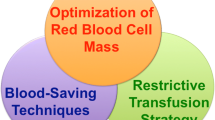Abstract
Cardiac surgery can be complicated by significant bleeding, particularly in patients with prior cardiothoracic surgery. Redo cardiac procedures can be complicated by adhesions and prolonged cardiopulmonary bypass (CPB), both of which can contribute to excessive bleeding. Approximately 30% of patients undergoing first-time elective coronary artery bypass grafting (CABG) surgery require a blood transfusion (Transfusion 41: 1193–203, 2001), and the likelihood of transfusion is even higher in cardiac reoperations (odds ratio 2.32; confidence interval 1.53–2.33) (Transfusion 46: 1120–9, 2006). Thus, the cardiothoracic surgeon and anesthesiologist need to be aware of the symptoms, signs, relevant laboratory tests, pathophysiology, and management strategies for excessive bleeding in the perioperative period of redo cardiac surgery.
Access this chapter
Tax calculation will be finalised at checkout
Purchases are for personal use only
Similar content being viewed by others
References
Karkouti K, Cohen MM, McCluskey SA, Sher GD. A multivariable model for predicting the need for blood transfusion in patients undergoing first-time elective coronary bypass graft surgery. Transfusion. 2001;41:1193–203.
Alghamdi AA, Davis A, Brister S, et al. Development and validation of transfusion risk understanding scoring tool (TRUST) to stratify cardiac surgery patients according to their blood transfusion needs. Transfusion. 2006;46:1120–9.
Ferraris VA, Ferraris SP, Saha SP, et al. Perioperative blood transfusion and blood conservation in cardiac surgery: the society of thoracic surgeons and the society of cardiovascular anesthesiologists clinical practice guideline. Ann Thorac Surg. 2007;83:S27–86.
Yavari M, Becker RC. Coagulation and fibrinolytic protein kinetics in cardiopulmonary bypass. J Thromb Thrombolysis. 2009;27:95–104.
Despotis GJ, Joist JH, Hogue Jr CW, et al. The impact of heparin concentration and activated clotting time monitoring on blood conservation. A prospective, randomized evaluation in patients undergoing cardiac operation. J Thorac Cardiovasc Surg. 1995;110:46–54.
Mochizuki T, Olson PJ, Szlam F, et al. Protamine reversal of heparin affects platelet aggregation and activated clotting time after cardiopulmonary bypass. Anesth Analg. 1998;87:781–5.
Shore-Lesserson L, Manspeizer HE, DePerio M, et al. Thromboelastography-guided transfusion algorithm reduces transfusions in complex cardiac surgery. Anesth Analg. 1999;88:312–9.
Royston D, von Kier S. Reduced haemostatic factor transfusion using heparinase-modified thrombelastography during cardiopulmonary bypass. Br J Anaesth. 2001;86:575–8.
Samama CM, Ozier Y. Near-patient testing of haemostasis in the operating theatre: an approach to appropriate use of blood in surgery. Vox Sang. 2003;84:251–5.
Murphy MF, Wallington TB, Kelsey P, et al. Guidelines for the clinical use of red cell transfusions. Br J Haematol. 2001;113:24–31.
Wang G, Bainbridge D, Martin J, Cheng D. The efficacy of an intraoperative cell saver during cardiac surgery: a meta-analysis of randomized trials. Anesth Analg. 2009;109:320–30.
Bracey AW, Radovancevic R, Riggs SA, et al. Lowering the hemoglobin threshold for transfusion in coronary artery bypass procedures: effect on patient outcome. Transfusion. 1999;39:1070–7.
Spotnitz WD, Burks S. Hemostats, sealants, and adhesives: components of the surgical toolbox. Transfusion. 2008;48:1502–16.
Fung MK, Moore K, Ridenour M, et al. Clinical effects of reverting from leukoreduced to nonleukoreduced blood in cardiac surgery. Transfusion. 2006;46:386–91.
Vamvakas EC. WBC-containing allogeneic blood transfusion and mortality: a meta-analysis of randomized controlled trials. Transfusion. 2003;43:963–73.
Boshkov LK, Furnary A, Morris C, et al. Prestorage leukoreduction of red cells in elective cardiac surgery: results of a double blind randomized controlled trial. Blood. 2004;104:112a.
Boshkov LK, Chien G, VanWinkle G, et al. Prestorage leukoreduction of transfused red cells is associated with significant ongoing 2–12 month survival benefit in cardiac surgery patients. Blood. 2004;104:174a.
Zimrin AB, Hess JR. Current issues relating to the transfusion of stored red blood cells. Vox Sanguinis. 2009;96:93–103.
Lelubre C, Piagnerelli M, Vincent JL. Association between duration of storage of transfused red blood cells and morbidity and mortality in adult patients: myth or reality? Transfusion. 2009;49:1384–94.
Hall K, Forrest P, Sawyer C. The effects of acidosis and hypothermia on blood transfusion requirements following factor VII administration. Anaesth Intensive Care. 2007;35:494–7.
Fergusson DA, Hebert PC, Mazer CD, et al. A comparison of aprotinin and lysine analogues in high-risk cardiac surgery. N Engl J Med. 2008;358:2319–31.
Author information
Authors and Affiliations
Corresponding author
Editor information
Editors and Affiliations
Rights and permissions
Copyright information
© 2012 Springer Science+Business Media, LLC
About this chapter
Cite this chapter
Padmanabhan, A., Triulzi, D.J. (2012). Transfusion Therapy in Reoperative Cardiac Surgery. In: Machiraju, V., Schaff, H., Svensson, L. (eds) Redo Cardiac Surgery in Adults. Springer, New York, NY. https://doi.org/10.1007/978-1-4614-1326-4_7
Download citation
DOI: https://doi.org/10.1007/978-1-4614-1326-4_7
Published:
Publisher Name: Springer, New York, NY
Print ISBN: 978-1-4614-1325-7
Online ISBN: 978-1-4614-1326-4
eBook Packages: MedicineMedicine (R0)




